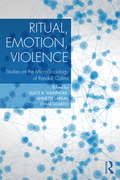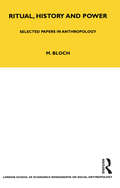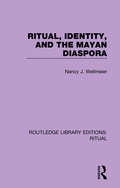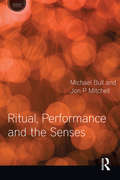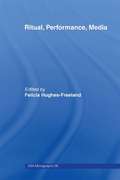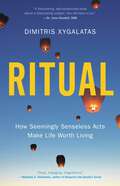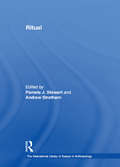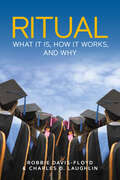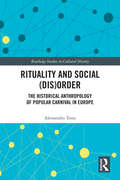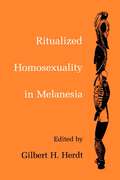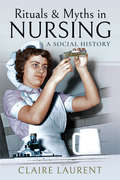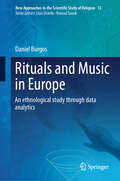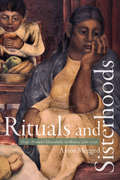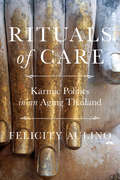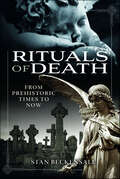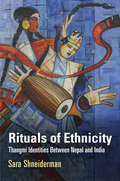- Table View
- List View
Ritual, Discourse, and Community in Cuban Santería: Speaking a Sacred World (Contemporary Cuba)
by Kristina WirtzAn insightful ethnographic account of the lives of Santería practitioners in CubaHow do Santería practitioners in Cuba create and maintain religious communities amidst tensions, disagreements, and competition among them, and in the absence of centralized institutional authority? What serves as the "glue" that holds practitioners of different backgrounds together in the creation of a moral community? Examining the religious lives of santeros in Santiago de Cuba, Wirtz argues that these communities hold together not because members agree on their interpretations of rituals but because they often disagree.Religious life is marked by a series of "telling moments"—not only the moments themselves but their narrated representations as they are retold and mined for religious meanings. Long after they occur, spiritually elevated experiences circulate in narratives that may express skepticism or awe and hold the promise of more such experiences. The author finds that these episodes resonate in gossip and other forms of public commentary about the experiences of their fellow Santería practitioners.Drawing on ethnographic research about Santería beliefs and practices, Wirtz observes that practitioners are constantly engaged in reflection about what they and other practitioners are doing, how the orichas (deities) have responded, and what the consequences of their actions were or will be. By focusing their reflective attention on particular events, santeros re-create, moment to moment, what their religion is. Wirtz also argues that Santeria cannot be considered in isolation from the complex religious landscape of contemporary Cuba, in which African-based traditions are viewed with a mix of fascination, folkloric pride, and suspicion. Interactions among the conflicting discourses about these religions—as sacred practices, folklore, or dangerous superstitions, for example—have played a central role in constituting them as social entities. This book will interest scholars of religion, the African diaspora, the Caribbean, and Latin America, as well as linguistic and cultural anthropologists.
Ritual, Emotion, Violence: Studies on the Micro-Sociology of Randall Collins
by Annette Lareau Elliott B. Weininger Omar LizardoMicrosociologists seek to capture social life as it is experienced, and in recent decades no one has championed the microsociological approach more fiercely than Randall Collins. The pieces in this exciting volume offer fresh and original insights into key aspects of Collins’ thought, and of microsociology more generally. The introductory essay by Elliot B. Weininger and Omar Lizardo provides a lucid overview of the key premises this perspective. Ethnographic papers by Randol Contreras, using data from New York, and Philippe Bourgois and Laurie Kain Hart, using data from Philadelphia, examine the social logic of violence in street-level narcotics markets. Both draw on heavily on Collins’ microsociological account of the features of social situations that tend to engender violence. In the second section of the book, a study by Paul DiMaggio, Clark Bernier, Charles Heckscher, and David Mimno tackles the question of whether electronically mediated interaction exhibits the ritualization which, according to Collins, is a common feature of face-to-face encounters. Their results suggest that, at least under certain circumstances, digitally mediated interaction may foster social solidarity in a manner similar to face-to-face interaction. A chapter by Simone Polillo picks up from Collins’ work in the sociology of knowledge, examining multiple ways in which social network structures can engender intellectual creativity. The third section of the book contains papers that critically but sympathetically assess key tenets of microsociology. Jonathan H. Turner argues that the radically microsociological perspective developed by Collins will better serve the social scientific project if it is embedded in a more comprehensive paradigm, one that acknowledges the macro- and meso-levels of social and cultural life. A chapter by David Gibson presents empirical analyses of decisions by state leaders concerning whether or not to use force to deal with internal or external foes, suggesting that Collins’ model of interaction ritual can only partially illuminate the dynamics of these highly consequential political moments. Work by Erika Summers-Effler and Justin Van Ness seeks to systematize and broaden the scope of Collins’ theory of interaction, by including in it encounters that depart from the ritual model in important ways. In a final, reflective chapter, Randall Collins himself highlights the promise and future of microsociology. Clearly written, these pieces offer cutting-edge thinking on some of the crucial theoretical and empirical issues in sociology today.
Ritual, Heritage and Identity: The Politics of Culture and Performance in a Globalised World
by Christiane BrosiusThis book explores the importance of ritual and ritual theory to discourses of authenticity and originality, thereby deepening our insight into concepts of cultural heritage, identity and nation in a globalised world. The volume is the first interdisciplinary attempt to understand the significance of rituals and related performative traditions in the creation of grounded cultural identities, ‘home’ and heritage as geographically experienceable locations. It assembles perspectives from social and cultural anthropology, performance studies, education and arts that can deal with the politics of revitalisation and preservation of ritualised traditions. While some chapters in this book emphasise on the ritualisation of cultural heritage by concentrating on power relations and politics, as well as actual processes of identification, especially for marginalised ethnic groups or migrant communities, others explore how rituals as intangible heritage are strategically employed by different groups all over the world to make their claims public and to improve and negotiate their position on a local, national or global platform. This book recognises ritualised performances as transnational and cross-cultural phenomena, which are not only tied to and defined via national territories and identities but which also demand new theoretical and methodological approaches towards the discussion of rituals and heritage.
Ritual, History and Power: Selected Papers in Anthropology (London School Of Economics Monographs On Social Anthropology Ser. #Vol. 58)
by Maurice BlochThis volume provides a collection of some of Maurice Bloch's most important work, including influential essays on power, hierarchy, death and fertility.
Ritual, Identity, and the Mayan Diaspora (Routledge Library Editions: Ritual #5)
by Nancy J. WellmeierOriginally published in 1998, Ritual, Identity, and the Mayan Diaspora examines the lives and the continuing ritual traditions of the Mayas in the United States. The book focuses on a predominantly Maya town in rural Florida and shows how members of this ancient Central American civilization use their religious tradition to maintain their ethnic identity in an unfamiliar environment. Bringing together studies of Mesoamerican fiesta or cargo systems, religious ritual and migration studies, this interdisciplinary work describes the religious traditions of indigenous Guatemala, the crisis migration of the 1980s, and the Mayas' daily life in the United States, including Maya women's reflections on their new challenges. The book is unique in its focus on the transfer of the fiesta cycle to the diaspora and its analysis of the behind-the-scenes aspects of ritual. The rise of leadership contested interpretations of ethnic identity, choices about symbolic representation, and maintenance of ties to villages of origin all take place in the context of organizing public ritual events. This book will be of interest to academics of anthropology, history and sociology.
Ritual, Myth and the Modernist Text: The Influence of Jane Ellen Harrison on Joyce, Eliot and Woolf
by Martha C. CarpentierFirst Published in 1998. Routledge is an imprint of Taylor & Francis, an informa company.
Ritual, Performance and the Senses (Sensory Studies)
by Michael BullRitual has long been a central concept in anthropological theories of religious transmission. Ritual, Performance and the Senses offers a new understanding of how ritual enables religious representations – ideas, beliefs, values – to be shared among participants. Focusing on the body and the experiential nature of ritual, the book brings together insights from three distinct areas of study: cognitive/neuroanthropology, performance studies and the anthropology of the senses. Eight chapters by scholars from each of these sub-disciplines investigate different aspects of embodied religious practice, ranging from philosophical discussions of belief to explorations of the biological processes taking place in the brain itself. Case studies range from miracles and visionary activity in Catholic Malta to meditative practices in theatrical performance and include three pilgrimage sites: the Church of the Holy Sepulchre in Jerusalem, the festival of Ramlila in Ramnagar, India and the mountain shrine of the Lord of the Shiny Snow in Andean Peru.Understanding ritual allows us to understand processes at the very centre of human social life and humanity itself, making this an invaluable text for students and scholars in anthropology, cognitive science, performance studies and religious studies.
Ritual, Performance, Media: Performance, Media, Identity (ASA Monographs #No.35)
by Felicia Hughes-FreelandRitual, Performance and Media are significant areas of study which are essential to anthropology and are often surprisingly overlooked. This book brings a more anthropological perspective to debates about media consumption, performativity and the characteristics of spectacle which have transformed cultural studies over the past decade.
Ritual, Performance, and Politics in the Ancient Near East
by Lauren RistvetIn this book, Lauren Ristvet rethinks the narratives of state formation by investigating the interconnections between ritual, performance, and politics in the ancient Near East. She draws on a wide range of archaeological, iconographic, and cuneiform sources to show how ritual performance was not set apart from the real practice of politics; it was politics. Rituals provided an opportunity for elites and ordinary people to negotiate political authority. Descriptions of rituals from three periods explore the networks of signification that informed different societies. From circa 2600 to 2200 BC, pilgrimage made kingdoms out of previously isolated villages. Similarly, from circa 1900 to 1700 BC, commemorative ceremonies legitimated new political dynasties by connecting them to a shared past. Finally, in the Hellenistic period, the traditional Babylonian Akitu festival was an occasion for Greek-speaking kings to show that they were Babylonian and for Babylonian priests to gain significant power.
Ritual, Play and Belief, in Evolution and Early Human Societies
by Colin Renfrew Michael Boyd Iain MorleyThe origins of religion and ritual in humans have been the focus of centuries of thought in archaeology, anthropology, theology, evolutionary psychology and more. Play and ritual have many aspects in common, and ritual is a key component of the early cult practices that underlie the religious systems of societies in all parts of the world. This book examines the formative cults and the roots of religious practice from the earliest times until the development of early religion in the Near East, in China, in Peru, in Mesoamerica and beyond. Here, leading prehistorians, biologists, and other specialists bring a fresh approach to the early practices that underlie the faiths and religions of the world. They demonstrate the profound role of play ritual and belief systems and offer powerful new insights into the emergence of early societies.
Ritual, Rapture and Rebellion: The Making of Market, Mercy and Meaning Amongst the Gitanos of El Rastro (New Anthropologies of Europe: Perspectives and Provocations #9)
by Marianne Blom BrodersenThe Gitanos of el Rastro carry an ‘ontology of simultaneity’ as self-employed traders and Pentecostal practitioners in Madrid. This makes the Spanish Romani be considered as both a part of and apart from mainstream society. This book is an anthropological account of a group of middle and upper-class Gitanos and their ways of creating a ‘society within society’ based upon distinct cultural, moral and ideological values, notions and practices. The study renders a comprehensive perspective on social processes of classification, stratification, ‘othering’ and the role of ‘strangers’ in society and how these processes unfold in the interface between social, ritual and economic life on a local to global scale.
Ritual, Violence, and the Fall of the Classic Maya Kings (Maya Studies)
by Gyles Iannone, Brett A. Houk and Sonja A. SchwakeMaya kings who failed to ensure the prosperity of their kingdoms were subject to various forms of termination, including the ritual defacing and destruction of monuments and even violent death. This is the first comprehensive volume to focus on the varied responses to the failure of Classic period dynasties in the southern lowlands. The contributors offer new insights into the Maya "collapse," evaluating the trope of the scapegoat king and the demise of the traditional institution of kingship in the early ninth century AD--a time of intense environmental, economic, social, political, and even ideological change. A volume in the series Maya Studies, edited by Diane Z. Chase and Arlen F. Chase
Ritual: How Seemingly Senseless Acts Make Life Worth Living
by Dimitris XygalatasRitual is perhaps the oldest, and certainly the most enigmatic, thread in human culture. Seemingly pointless ceremonies pervade every known society: from handshakes to hexes, hazings to parades, birthdays to graduations. Before we ever learned to farm, we were gathering in giant stone temples. And yet, though rituals exist in every culture and can persist nearly unchanged for centuries, their logic has remained a mystery until now.Today, a fearless new generation of anthropologists is venturing into this shadowy realm. Armed with cutting-edge technology and drawing on discoveries from a wide range of disciplines, they emerge with a powerful new perspective on our place in the world. Pathfinding scientist Dimitris Xygalatas reveals the deep and subtle mechanisms that bind us together.
Ritual: How Seemingly Senseless Acts Make Life Worth Living
by Dimitris XygalatasA pioneering anthropologist takes readers on a 'fascinating, well-researched' (Dr. Jane Goodall, DBE) journey through the rich tapestry of human ritual—showing how and why our most irrational behaviors are a key driver of our success." Ritual is one of the oldest, and certainly most enigmatic, threads in the history of human culture. It presents a profound paradox: people ascribe the utmost importance to their rituals, but few can explain why they are so important. Apparently pointless ceremonies pervade every documented society, from handshakes to hexes, hazings to parades. Before we ever learned to farm, we were gathering in giant stone temples to perform elaborate rites and ceremonies. And yet, though rituals exist in every culture and can persist nearly unchanged for centuries, their logic has remained a mystery—until now. In Ritual, pathfinding scientist Dimitris Xygalatas leads us on an enlightening tour through this shadowy realm of human behavior. Armed with cutting-edge technology and drawing on discoveries from a wide range of disciplines, he presents a powerful new perspective on our place in the world. In birthday parties and coronations, in silent prayer, in fire-walks and terrifying rites of passage, in all the bewildering variety of human life, Ritual reveals the deep and subtle mechanisms that bind us together.
Ritual: Key Concepts In Religion (The International Library of Essays in Anthropology #3)
by Andrew StrathernThis volume consists of a number of carefully-selected readings that represent a wide range of discussions and theorizing about ritual. The selection encompasses definitional questions, issues of interpretation, meaning, and function, and a roster of ethnographic and analytical topics, covering classic themes such as ancestor worship and sacrifice, initiation, gender, healing, social change, and shamanic practices, as well as recent critical and reconstructive theorizing on embodiment, performance, and performativity. In their Introduction to the volume, the Editors provide an overall survey and critical consideration of topics, incorporating insights from their own long-term field research and reflections on the readings included. The Introduction and readings together provide a unique research tool for those interested in pursuing the study of ritual processes in depth, with the benefit of both historical and contemporary approaches.
Ritual: What It Is, How It Works, and Why
by Robbie Davis-Floyd Charles D. LaughlinDesigned for both academic and lay audiences, this book identifies the characteristics of ritual and, via multiple examples, details how ritual works on the human body and brain to produce its often profound effects. These include enhancing courage, effecting healing, and generating group cohesion by enacting cultural—or individual—beliefs and values. It also shows what happens when ritual fails.
Rituality and Social: The Historical Anthropology of Popular Carnival in Europe (Routledge Studies in Cultural History #98)
by Alessandro TestaCarnival has been described as one of the foundational elements of European culture, bearing an emblematic and iconic status as the festive phenomenon par excellence. Its origins are partly obscure, but its stratified and complex history, rich symbolic diversity, and sundry social configurations make it an exceptional object of cultural analysis. The product of more than 12 years of research, this book is the first comparative historical anthropology of popular European Carnival in the English language, with a focus on its symbolic, religious, and political dimensions and transformations throughout the centuries. It builds on a variety of theories of social change and social structures, questioning existing assumptions about what folklore is and how cultural gaps and differences take shape and reproduce through ritual forms of collective action. It also challenges recent interpretations about the performative and political dimension of European festive culture, especially in its carnivalesque declension. While presenting and exploring the most important features and characteristics of European pre-modern Carnival and discussing its origins and developments, this thorough study offers fresh evidence and up-to-date analyses about its transversal and long-lasting significance in European societies.
Ritualized Homosexuality in Melanesia (Studies in Melanesian Anthropology #2)
by Gilbert H. HerdtThis book contains the work of seven leading anthropologists on the subject of ritualized homosexuality, and it marks the first time that anthropologists have systematically studied cross-cultural variations in homosexual behavior in a non-Western culture area. The book as a whole indicates that contemporary theories of sex and gender development need revision in light of the Melanesian findings.
Rituals & Myths in Nursing: A Social History
by Claire LaurentThe rich history of British nursing comes to life in this lighthearted volume exploring the traditions and experiences of nurses across the 20th century. Nursing in the United Kingdom has been steeped in tradition since the Nurses Registration Act of 1919. Many of the customs and methods practiced today have been passed down through the generations. Rituals & Myths of Nursing collects amusing and poignant reminiscences of nursing through the 20th century to paint a picture of this unique profession from the first registration of SRN No 1, Ethel Gordon Fenwick, to the present day. Written with humor and a light touch, each chapter explores a theme with stories told by nurses from different eras. We have tales of alcohol prescribed to dilate blood vessels or simply for the feel-good factor. Enemas were less fun for everyone concerned, but highly common as they were given for almost all bowel conditions.
Rituals and Music in Europe: An ethnological study through data analytics (New Approaches to the Scientific Study of Religion #13)
by Daniel BurgosThis book explores modern European religious and non-religious rituals and their main features by focusing on music as a key element required for the full expression of beliefs. It specifically examines the relationship between religious, non-religious, pagan, cultural, celebratory, and traditional rituals. In doing so, this text focuses on the extent to which the rituals overlap, replace, or feed religious or pseudo-religious beliefs to create alternative beliefs (individual or collective) that systematically ignore any religion. The book further analyses the relationship between daily habits, holidays, sports, politics, culture, and other pagan rituals as forms that represent social feelings by identifying, enjoying, or impersonating emotions; and transversally, it explores how music facilitates and fosters those emotions. The volume also investigates how rituals coexist and mutually influence each other through a representation of religious and non-religious rituals, and how music plays a central role in that phenomenology. The author argues that music is a key part of various types of rituals (e.g. rites of passage), and that music supports and enriches the meaning of the ritual, to ultimately strengthen the bond of communication with the individual and the group. This monograph appeals to students and researchers working in religious studies and in music theory.
Rituals and Practices with the Motherpeace Tarot
by Vicki NobleA spiritual guidance system with rituals to tap into and manifest feminine divine energy through the Motherpeace deck• Contains over 20 rituals, exercises, and readings that integrate tarot with spiritual practice, rites, and celebrations • Demonstrates how Motherpeace cards may be used to improve health, relationships, and personal insight; celebrate holidays; and commune with the divine forces of the universe • By the cocreator of the Motherpeace deck (more than 200,000 copies sold) First printed during the crest of the women’s spirituality movement, the Motherpeace deck created a sensation as a multicultural tarot designed specifically for women. Depicting people of color, older women, children, animals, and balanced roles for men and women, the Motherpeace deck embraces images from ancient cultures and contemporary tribal peoples to convey the fundamental principles of cooperation, relatedness, egalitarianism, and ecstatic communion. Rituals and Practices with the Motherpeace Tarot offers a deep spiritual practice that taps into and manifests the divine feminine through ritual readings, rites of passage, daily meditative practice, and seasonal celebration. Vicki Noble teaches how to use the imagery of the Motherpeace deck to read the past, present, and future; invoke good health on all planes; nurture healthy relationships; receive divine guidance during critical decision-making; and celebrate sacred holidays. Her book is a useful tool for both beginners and those with extensive knowledge of tarot.
Rituals and Sisterhoods: Single Women's Households in Mexico, 1560–1750
by Amos MeggedRituals and Sisterhoods reveals the previously under-studied world of plebeian single women and single-female-headed households in colonial Mexican urban centers. Focusing on the lower echelons of society, Amos Megged considers why some commoner women remained single and established their own female-headed households, examining their unique discourses and self-representations from various angles. Megged analyzes these women’s life stories recorded during the Spanish Inquisition, as well as wills and bequests, petitions, parish records, and private letters that describe—in their own words—how they exercised agency in male-dominated and religious spaces. Translations of select documents and accompanying analysis illustrate the conditions in which women dissolved their marriages, remained in long-lasting extramarital cohabitations, and formed female-led households and “sisterhoods” of their own. Megged provides evidence that single women in colonial Mexico played a far more active and central role in economic systems, social organizations, cults, and political activism than has been previously thought, creating spaces for themselves in which they could initiate and maintain autonomy and values distinct from those of elite society. The institutionalization of female-headed households in mid-colonial Mexico had wide-ranging repercussions and effects on general societal values. Rituals and Sisterhoods details the particular relevance of these changes to the history of emotions, sexuality, gender concepts, perceptions of marriage, life choices, and views of honor and shame in colonial society. This book will be of significant interest to students and scholars of colonial Latin American history, the history of Early Modern Spain and Europe, and gender and women’s studies.
Rituals of Care: Karmic Politics in an Aging Thailand
by Felicity AulinoEnd-of-life issues are increasingly central to discussions within medical anthropology, the anthropology of political action, and the study of Buddhist philosophy and practice. Felicity Aulino's Rituals of Care speaks directly to these important anthropological and existential conversations. Against the backdrop of global population aging and increased attention to care for the elderly, both personal and professional, Aulino challenges common presumptions about the universal nature of "caring." The way she examines particular sets of emotional and practical ways of being with people, and their specific historical lineages, allows Aulino to show an inseparable link between forms of social organization and forms of care.Unlike most accounts of the quotidian concerns of providing care in a rapidly aging society, Rituals of Care brings attention to corporeal processes. Moving from vivid descriptions of the embodied routines at the heart of home caregiving to depictions of care practices in more general ways—care for one's group, care of the polity—it develops the argument that religious, social, and political structures are embodied, through habituated action, in practices of providing for others. Under the watchful treatment of Aulino, care becomes a powerful foil for understanding recent political turmoil and structural change in Thailand, proving embodied practice to be a vital vantage point for phenomenological and political analyses alike.
Rituals of Death: From Prehistoric Times to Now
by Stan BeckensallWe all must die, and how society deals with the disposal is fascinating in the way it reflects the beliefs of the people of the time and ways in which they honor or do not honor the dead. Having excavated prehistoric burials, the author weighs carefully the evidence of what people might have thought of the dead through the way they buried them and what was put into the graves. These excavations were done mainly with the help of young people, and the way that this has been organised in order to get the maximum information has been an essential part of the task. The author provides much detail of this that makes it more interesting and personal. Burial customs change, so the book includes a section on events such as the Black Death and cholera to show how such catastrophes change people's minds and customs. The present problem of burial has been highlighted as it was then by the horror of an invisible disease, the effects of which we have to cope with. In the past the causes of the disease, when discovered, led to Public health inquiries into the causes, and to improvements in some burial grounds. The traditional burial in “God's little Acre' around a church provides with much information about people through their headstones and other monuments – something accessible to all who visit our churches today, and examples from Northumberland give a typical range of what we find there.
Rituals of Ethnicity: Thangmi Identities Between Nepal and India (Contemporary Ethnography)
by Sara ShneidermanRituals of Ethnicity is a transnational study of the relationships between mobility, ethnicity, and ritual action. Through an ethnography of the Thangmi, a marginalized community who migrate between Himalayan border zones of Nepal, India, and the Tibetan Autonomous Region of China, Shneiderman offers a new explanation for the persistence of enduring ethnic identities today despite the increasing realities of mobile, hybrid lives. She shows that ethnicization may be understood as a process of ritualization, which brings people together around the shared sacred object of identity.The first comprehensive ethnography of the Thangmi, Rituals of Ethnicity is framed by the Maoist-state civil conflict in Nepal and the movement for a separate state of Gorkhaland in India. The histories of individual nation-states in this geopolitical hotspot—as well as the cross-border flows of people and ideas between them—reveal the far-reaching and mutually entangled discourses of democracy, communism, development, and indigeneity that have transformed the region over the past half century. Attentive to the competing claims of diverse members of the Thangmi community, from shamans to political activists, Shneiderman shows how Thangmi ethnic identity is produced collaboratively by individuals through ritual actions embedded in local, national, and transnational contexts. She builds upon the specificity of Thangmi experiences to tell a larger story about the complexities of ethnic consciousness: the challenges of belonging and citizenship under conditions of mobility, the desire to both lay claim to and remain apart from the civil society of multiple states, and the paradox of self-identification as a group with cultural traditions in need of both preservation and development. Through deep engagement with a diverse, cross-border community that yearns to be understood as a distinctive, coherent whole, Rituals of Ethnicity presents an argument for the continued value of locally situated ethnography in a multisited world.Cover art: Lost Culture Can Not Be Reborn, painting by Mahendra Thami, Darjeeling, West Bengal, India.

